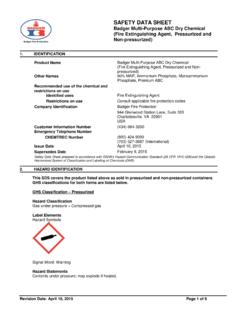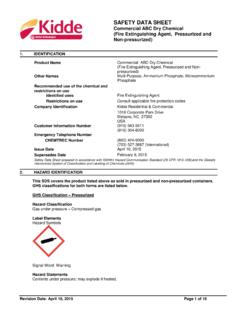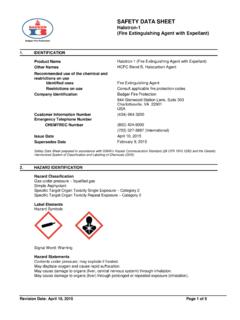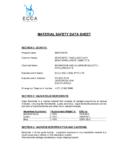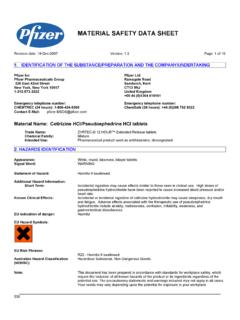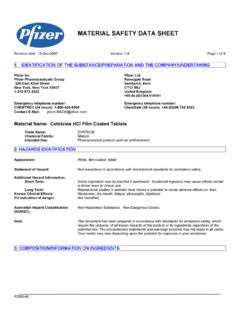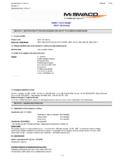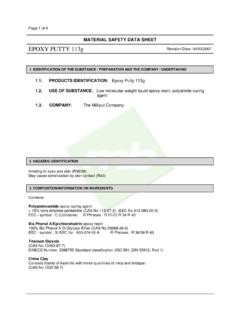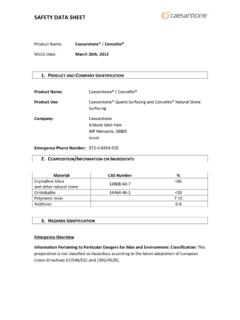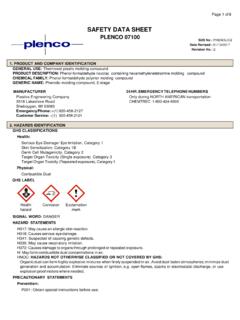Transcription of SAFETY DATA SHEET - Brooks Equipment
1 SAFETY data SHEET . Section 1. PRODUCT AND COMPANY IDENTIFICATION. Product Name: ABC Dry Chemical Fire Extinguishant Other Identifiers: Multi-purpose Dry Chemical Product Code(s): CH550, F15, F18. Model Code(s) for Extinguishers: 411, 417, 419, 423, 424, 425, 441, 443, 450, 456, 461, 464, 467, 470, 473, 476, 481, 487, 488, 491, 495, 500, 564, 567, 573, 581, 589, 592, 594, 668, 692, 720, 760, 763, 781. Recommended Use: Fire suppression, not for human or animal drug use. Manufacturer: AMEREX CORPORATION. Internet Address: Address: 7595 Gadsden Highway, Box 81. Trussville, AL 35173-0081. Company Telephone: (205) 655-3271. E-mail Address: Emergency Contacts: Chemtrec 1(800) 424-9300 or (703) 527 3887. Revised: May, 2016. Section 2. HAZARDS IDENTIFICATION. GHS Classification Health Environmental Physical Acute Toxicity: Category 5 None None Skin Corrosion/Irritation: Category 3 None None Skin Sensitization: NO None None Eye: Category 2B None Warning STOT Category 3 None Warning Carcinogen: Category None None None GHS Label Symbol(s): Exclamation Mark GHS Signal Word(s): Warning Other Hazards Not Resulting in Classification: None Page 1 of 13 Pages ABC.
2 GHS Hazard Phrases GHS Hazard GHS Codes(s) Code Phrase(s). Physical None Health H303 May be harmful if swallowed 316 Causes mild skin irritation 320 Causes eye irritation 333 May be harmful if inhaled Environmental None Precautionary: General P101 If medical advice is needed, have product container or label at hand Prevention P261 Avoid breathing dust. 264 Wash hands and face thoroughly after handling. Response P304+340 If inhaled, remove person to fresh air and keep comfortable for breathing. 305+351+313 If in eyes, rinse cautiously with water for several minutes. Get immediate medical advice/attention (as appropriate). 337+338 If eye irritation persists: remove contact lenses, if present and easy to do. Continue rinsing. P312 Call a POISON CENTER/doctor if you feel unwell (as appropriate). Storage None Section 3. COMPOSITION/INFORMATION ON INGREDIENTS. Chemical Name EC No. REACH Reg.
3 No. CAS-No. Weight %. Mono-ammonium phosphate NA NA 7722-76-1 55-75. Ammonium sulfate 231-984-1 NA 7783-20-2 20-40. Fullers earth NA Not Available 8031-18-3 <3. magnesium aluminum silicate Mica- NA Not Available 12001-26-2 1-2. potassium aluminum silicate Silicone oil NA Not Available 63148-57-2 <1. methyl hydrogen polysiloxane Calcium carbonate 215-279-6 Not Available 1317-65-3 <1. Amorphous silica 262-373-8 Not Available 112926-00-8 <1. precipitated synthetic zeolite Yellow 14 pigment diazo dye 228-767-9 Not Available 5468-75-7 <1. Emergency overview: Light yellow, fine solid powder, odorless. Adverse health effects and symptoms: Irritant to the respiratory system; Irritating to eyes and skin. Symptoms may include coughing, shortness of breath, and irritation of the lungs, eyes, and skin. Ingestion, although unlikely, may cause cramps, nausea and diarrhea. Cut-off Levels Chemical Name Reproductive Carcinogenicity Mutagenicity Other Hazard Toxicity Classes Mono-ammonium Phosphate NA NA NA NA.
4 Ammonium Sulfate NA NA NA NA. Page 2 of 13 Pages ABC. Fullers earth NA NA NA NA. magnesium aluminum silicate Mica- NA NA NA NA. potassium aluminum silicate Silicone oil NA NA NA NA. methyl hydrogen polysiloxane Calcium carbonate NA NA NA NA. Amorphous silica NA NA NA NA. precipitated synthetic zeolite Yellow 14 pigment di-azo dye NA NA NA NA. Section 4. FIRST AID MEASURES. Eye Exposure: May cause irritation. Irrigate eyes with water and repeat until pain free. Seek medical attention if irritation develops, or if vision changes occur. Skin Exposure: May cause skin irritation. In case of contact, wash with plenty of soap and water. Seek medical attention if irritation persists. Inhalation: May cause irritation, along with coughing. If respiratory irritation or distress occurs, remove victim to fresh air. Seek medical attention if irritation persists. Ingestion: Overdose symptoms may include numbness or tingling in hands or feet, uneven heart rate, paralysis, feeling faint, chest pain or heavy feeling, pain spreading to the arm or shoulder, nausea, diarrhea, sweating, general ill feeling, or seizure (convulsions).
5 If victim is conscious and alert, give 2-3 glasses of water to drink. If conscious, do not induce vomiting. Seek immediate medical attention. Do not leave victim unattended. To prevent aspiration of swallowed product, lay victim on side with head lower than waist. Medical conditions possibly aggravated by exposure: Inhalation of product may aggravate existing chronic respiratory problems such as asthma, emphysema, or bronchitis. Skin contact may aggravate existing skin disease. Chronic overexposure may cause pneumoconiosis ( dusty lung disease). Page 3 of 13 Pages ABC. Section 5. FIRE-FIGHTING MEASURES. Flammable Properties: Not flammable Flash Point: Not determined Suitable Extinguishing Media: Non-combustible. Use extinguishing media suitable for surrounding conditions. Hazardous Combustion Products: Carbon and sulfur oxides Explosion data : Sensitivity to Mechanical Impact: Not sensitive Sensitivity to Static Discharge: Not sensitive Unusual fire/explosion hazards: In a fire this material may decompose, releasing oxides of carbon, sulfur, potassium and nitrogen (see Section 10).
6 Protective Equipment and Precautions for Firefighters: As in any fire, wear self-contained breathing apparatus in pressure-demand, NIOSH approved or equivalent and full protective gear. Section 6. ACCIDENTAL RELEASE MEASURES. Personal Precautions: Avoid contact with skin, eyes, and clothing. Personal Protective Equipment : Minimum - SAFETY glasses, gloves, and a dust respirator. Emergency Procedures: NA. Methods for Containment: Prevent further leakage or spillage if safe to do so. Methods for Clean Up: Avoid dust formation. Clean up released material using vacuum or wet sweep and shovel to minimize generation of dust. Bag and transfer to properly labeled containers. Ventilate area and wash spill site after material pickup is complete. Environmental Precautions: Prevent material from entering waterways. Other: If product is contaminated, use PPE and containment appropriate to the nature of the most toxic chemical/material in the mixture.
7 Page 4 of 13 Pages ABC. Section 7. HANDLING AND STORAGE. Personal Precautions: Use appropriate PPE when handling or maintaining Equipment , and wash thoroughly after handling (see Section 8). Conditions for Safe Storage/Handling: Keep product in original container or extinguisher. Contents may be under pressure inspect extinguisher consistent with product labeling to ensure container integrity. Incompatible Products: Do not mix with other extinguishing agents, particularly potassium bicarbonate and sodium bicarbonate. Incompatible with strong oxidizing agents and strong acids. Do not store in high humidity. Do not combine with chlorine compounds. Section 8. EXPOSURE CONTROLS/PERSONAL PROTECTION. Chemical OSHA PEL ACGIH TLV DFG MAK * EU BLV. Name Mono- PNOC** PNOC PNOC NA. ammonium Total dust, 15 mg/m3 Total dust, 10 mg/m3 Total dust, 4 mg/m 3. phosphate Respirable fraction, 5 mg/m3 Respirable fraction, 3 Respirable fraction, mg/m3 mg/m3.
8 Ammonium PNOC** PNOC PNOC NA. Sulfate Total dust, 15 mg/m3 Total dust, 10 mg/m3 Total dust, 4 mg/m 3. Respirable fraction, 5 mg/m3 Respirable fraction, 3 Respirable fraction, mg/m3 mg/m3. Mica 6 mg/m3 3 mg/m3 NR NA. Fullers Earth PNOC** PNOC PNOC. Total dust, 15 mg/m3 Total dust, 10 mg/m3 Total dust, 4 mg/m 3. Respirable fraction, 5 mg/m3 Respirable fraction, 3 Respirable fraction, mg/m3 mg/m3. Silicone oil NR** NR NR NA. Calcium PNOC PNOC NA. carbonate Total dust, 15 mg/m3 Total dust, 10 mg/m3 ------- Respirable fraction, 5 mg/m3 Respirable fraction, 3. mg/m3. Amorphous 80 mg/m3 % silica 10 mg/m3 4 mg/m3 NA. silica Yellow 14 NR NR NR NA. pigment *German regulatory limits **PNOC = Particulates not otherwise classified (ACGIH) also known as Particulates not otherwise regulated (OSHA) ** NR = Not Regulated. All values are 8 hour time weighted average concentrations. Page 5 of 13 Pages ABC.
9 Engineering Controls: Showers Eyewash stations Ventilation systems Personal Protective Equipment PPE Code E: The need for respiratory protection is not probable during short-term exposure. PPE use during production process must be independently evaluated. Eye/Face Protection: Tightly fitting SAFETY goggles Skin and Body Protection: Wear protective gloves/coveralls Respiratory Protection: If exposure limits are exceeded or irritation is experienced, NIOSH approved respiratory protection should be worn. Use P100 respirators for limited exposure, use air-purifying respirator (APR) with high efficiency particulate air (HEPA) filters for prolonged exposure. Positive-pressure supplied air respirators may be required for high airborne contaminant concentrations. Respiratory protection must be provided in accordance with current SAFETY and health requirements. The need for respiratory protection is not likely for short-term use in well ventilated areas.
10 Hygiene Measures: Good personal hygiene practice is essential, such as avoiding food, tobacco products, or other hand-to- mouth contact when handling. Wash thoroughly after handling. Section 9. PHYSICAL AND CHEMICAL PROPERTIES. Appearance: Light yellow powder, finely divided odorless solid Molecular Weight: NH4H2PO4: ; (NH4)2SO4: Page 6 of 13 Pages ABC. Odor: Odorless Odor Threshold: No information available Decomposition Temperature OC: 100 - 120. Freezing Point OC: No information available Initial Boiling Point OC: No information available Physical State: Crystalline Powder pH: Mixture approximately 4 to 5; NH4H2PO4: in molar solution; (NH4)2SO4: in molar solution Flash Point OC: None Auto-ignition Temperature OC: None Boiling Point/Range OC: Not Applicable Melting Point/Range OC: NH4H2PO4: 190; (NH4)2SO4: 280. Flammability: Not Flammable Flammability Limits in Air OC: Upper Not Flammable; Lower-Not Flammable Explosive Properties: None Oxidizing Properties: None Volatile Component (%vol) Not Applicable Evaporation Rate: Not Applicable Vapor Density: Not Applicable Vapor Pressure: Not Applicable Specific gravity at 25 C: NH4H2PO4: ; (NH4)2SO4:: Solubility: Coated-Not Immediately Soluble in Water Partition Coefficient: NH4H2PO4 Est: ; (NH4)2SO4: Est: Viscosity: Not Applicable NOTE: NH4H2PO4 Monoammonium Phosphate; (NH4)2SO4: Ammonium Sulfate Section 10.

